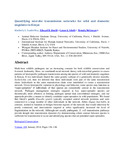| dc.description.abstract | Multi-host wildlife pathogens are an increasing concern for both wildlife conservation and livestock husbandry. Here, we combined social network theory with microbial genetics to assess patterns of interspecific pathogen transmission among ten species of wild and domestic ungulates in Kenya. If two individuals shared the same genetic subtype of a genetically diverse microbe, Escherichia coli, then we inferred that these individuals were part of the same transmission chain. Individuals in the same transmission chain were interlinked to create a transmission network. Given interspecific variation in physiology and behavior, some species may function as “super-spreaders” if individuals of that species are consistently central in the transmission network. Pathogen management strategies targeted at key super-spreader species are theoretically more effective at limiting pathogen spread than conventional strategies, and our approach provides a means to identify candidate super-spreaders in wild populations. We found that Grant’s gazelle (Gazella granti) typically occupied central network positions and were connected to a large number of other individuals in the network. Zebra (Equus burchelli), in contrast, seemed to function as bridges between regions of the network that would otherwise be poorly connected, and interventions targeted at zebra significantly increased the level of fragmentation in the network. Although not usually pathogenic, E. coli transmission pathways provide insight into transmission dynamics by demonstrating where contact between species is sufficient for transmission to occur and identifying species that are potential super-spreaders. | en_US |

